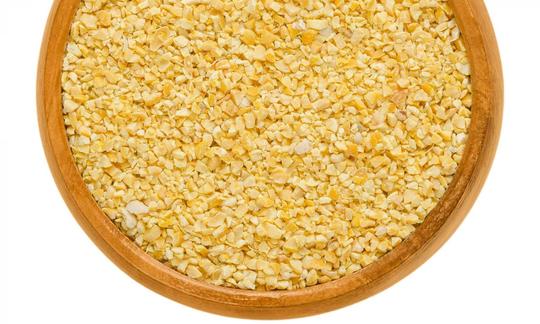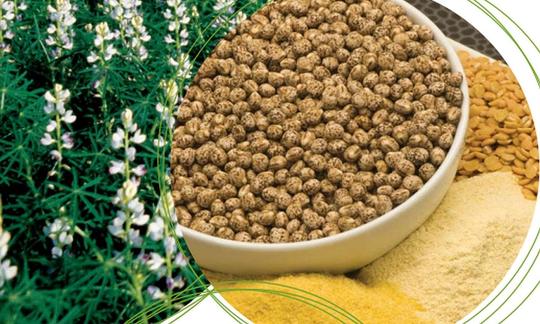Table of contents
For the production of raw lupine meal or sweet lupine meal, the seeds of the cultivated and therefore non-toxic sweet lupine ( Lupinus L. ssp.) or wolf bean are used.
Use in the kitchen
What is lupin meal? Lupin meal is made from whole, peeled lupin seeds that are roughly crushed in a roller. Lupin meal is raw, gluten-free, grainy to the bite and has a sweet, grainy to nutty taste. One advantageous aspect of sweet lupins compared to wild varieties and some other legumes such as soybeans : sweet lupin products do not have any problematic ingredients.
Should you cook or soak lupine meal? Lupine meal (from sweet lupins) can be eaten raw or cooked beforehand. However, soaking or cooking processes are not absolutely necessary. The protein-rich meal can be used without soaking in muesli or when preparing patties.
Other uses of sweet lupine meal include pre-cooking (approx. 5 minutes) and then soaking (10 minutes), which produces a type of porridge. Popular preparation methods include salads, tabbouleh and use in vegan Bolognese sauces or lasagne as a meat alternative. You can soak whole seeds overnight and cook them for approx. 2 hours. Even then, they are still very firm. Lupine seeds can also be peeled when cooked, similar to almonds or chickpeas.
Alternatively, you can create unheated spreads or sauces by letting around 100 g of groats soak in 250 ml of water for several hours (at least 3 hours) and then processing them further. In certain recipes, flour can also be replaced with lupine groats, although pure lupine flour is better suited for this.
A special lupin product known in the Mediterranean region is pickled lupin seeds, especially as a snack in restaurants (wolf beans). For vegan diets and products suitable for them, pure lupin protein (lupin protein isolate) is used to make milk substitutes such as yoghurt, cheese or ice cream; this protein has very little taste of its own. 1 Lupin tofu, a tofu-like product made from lupin flour, is also a particularly tasty source of protein. 2 The product marketed as "Lopino" is no longer available, however.
By roasting the fruit, you can also make a coffee-like, caffeine-free drink. Altreier coffee, for example, consists of roasted lupine seeds that are ground and poured over with hot water. 21
Does lupin meal taste bitter? The lupins available today are non-toxic cultivated forms and no longer taste bitter.
Vegan recipe for lupin patties
Ingredients (for 4 people): 200 g lupine meal, 350 ml hot water, 130 g carrots, 60 g leeks, 30 g onions, 1 tbsp parsley (finely chopped), 20 g egg substitute (e.g. okara or aquafaba), 60 ml cold water, 4 tbsp yeast flakes, sea salt,pepper, 2 tbsp vegetable oil for frying (e.g. rapeseed oil).
Preparation: Put the sweet lupine meal in a bowl and pour hot water over it, cover and leave to swell for 15-20 minutes. Peel and finely grate the carrots, finely chop the leek and onion. Puree the vegetables together with the swollen lupine meal. If it is too dry, you can add about 5-6 tablespoons of vegetable stock. Mix the egg substitute mixed with cold water together with the parsley and yeast flakes. Season with salt and pepper. Form about 12 patties from this amount and fry on both sides. This goes well with salad and dip, for example.
Vegan recipe for cucumber tabbouleh
Ingredients: 44 g sweet lupine meal, 150 ml lemon juice (about 2 lemons), 1 onion, 135 g parsley (finely chopped), 2 tomatoes (diced), 1 half cucumber, 50 ml mint (chopped), 2 tbsp vegetable oil (e.g. rapeseed oil), sea salt,pepper, 1 tbsp soy sauce.
Preparation: Boil sweet lupin meal in water for 3 minutes. Drain and rinse a few times, then drain the water very well. Put all the herbs and vegetables in a bowl. Add the lupins, lemon juice, rapeseed oil and soy sauce to the bowl. Mix well and season with sea salt and black pepper. Serve cold.
Vegan recipes with sweet lupin meal can be found under the note: " Recipes that have the most of this ingredient ".
| Not only vegans or vegetarians should read this: Vegans often eat unhealthily. Avoidable nutritional errors. |
Purchasing - Storage
You will rarely find sweet lupin meal at major retailers such as Coop, Migros, Denner, Volg, Spar, Aldi, Lidl, Rewe, Edeka, Hofer, Billa etc. Lupins as a whole (dried or pickled) as well as meal, flakes, flour or protein powder are almost exclusively available in organic supermarkets ( Denn's Biomarkt, Alnatura), organic shops, health food stores, drugstores or on the Internet. You can also buy organic lupin milk there. Processed products are more likely to go bad because the seed husks are destroyed. This is why they are often heated (toasted) and no longer raw. Find out about the production method if you want to buy a raw food product. The ground seeds are usually made from blue or white sweet lupins. Packaged in a 250 g bag, lupin meal is available all year round.
Larger supermarkets sell lupin products such as vegan cheese (as a spread, to melt, grated and in chunks) and lupin ice cream. These products often contain a lot of additives, so it's worth reading the ingredients list.
The availability of lupin meal varies depending on the size of the store, catchment area, etc. Our recorded food prices for the DA-CH countries can be found above under the ingredient image - and by clicking you can see their development at various suppliers.
Storage tips
Lupine meal can be stored for several months if kept dry, dark and airtight. Toasted products last for up to a year. It is better to buy the whole grains and grind them when needed. Whole, untreated, germinable, i.e. "living" grains last for years.
Ingredients - Nutritional values - Calories
The calorie content of sweet lupin meal is approximately 371 kcal/100g. Carbohydrates (40 g/100g) make up the largest proportion, closely followed by protein (36 g/100g). The fat content (9.7 g/100g) is not as high as in soybeans (20 g/100g), but is still considerable. The highfiber content (19 g/100g) in sweet lupin meal can lead to a rapid feeling of satiety. 5
100 g of lupin meal contains around 355 µg of folic acid. This covers more than the average daily requirement. 5 The proportion in kidney beans is even higher at 394 µg/100g, as in many other pulses, but these are not edible raw. When cooked, the folic acid content of kidney beans is reduced to around 130 µg/100g. 5 Folate, as a folic acid-active substance group, is a water-soluble vitamin and important for cell renewal.
Lupine contains all essential amino acids. Threonine is particularly abundant: 100 g contain 1.3 g. Unpeeled hemp seeds have the same value. Soya bean powder (2.1 g/100g) and brewer's yeast (2.7 g/100g) have higher values. 5
The trace element manganese is also present in high amounts at 2.4 mg/100g. Millet (1.6 mg/100g) and almonds (2.2 mg/100g) have similar values. Teff has a much higher value at 9.2 mg/100g. 5 Manganese is important for the formation of cartilage in the body.
The complete ingredients of lupin meal (raw), the coverage of the daily requirement and comparison values with other ingredients can be found in our nutrient tables. In the article Nutrients explained you will get a detailed insight into the topic.
Effects on health
Is lupine meal healthy? In contrast to other legumes, lupine seeds are very well tolerated and cause flatulence much less frequently than other legumes. In addition, lupine is gluten-free and suitable for people with gluten intolerance or celiac disease. 24 This is why lupine milk is also healthy. But 'healthy' or 'unhealthy' always depends on the amount. The low glycemic index (< 50) of whole sweet lupine also leads to a slow increase in blood sugar levels, which makes them very well tolerated by people with diabetes. 20 In addition, the alkaline protein in lupine causes less uric acid. This makes lupine well suited for people who have to follow a low-purine diet as a result of rheumatism or gout. 20,26
Lupin protein has a similarly high biological value to soy protein and is a popular source of protein, especially among vegetarians and vegans. Depending on the type of lupin, the shell content can be very high: yellow lupin has around 30% shell content, blue lupin 25% and white lupin 15%. These seed shells are very hard and the fiber content of the seeds is still very high even without shell content. 7
Secondary plant substances
Many of the health effects of lupine meal can be attributed to the secondary plant substances it contains. Our article on secondary plant substances provides an overview of the classification of substance groups, their occurrence in foods and possible effects on humans. Lupine meal contains the following secondary plant substances, among others: 6
- Isoprenoids : Triterpenoids
- Polyphenols : flavonoids (isoflavonoids)
- Alkaloids
However, it should be noted that the composition of secondary plant substances in lupin meal can vary depending on the variety, time of harvest and growing conditions. Therefore, quantities are only of limited use and should only be understood roughly.
Dangers - Intolerances - Side effects
Lupins, like all protein-rich foods, have an increased allergy potential. 9 Some people develop a sensitization to lupin components. This allergy to certain proteins (conglutins) 10,11 can occur in isolation or as a cross-allergy (mostly in cases of sensitization to peanuts). 12,13
In addition to peanuts, there are also other cross-reactions with foods from the same botanical family, for example with chickpeas and beans. The problem here is the current obligation to declare lupins as an ingredient, which does not apply equally in all countries. In many European countries there is a special labelling requirement - even for the smallest quantities or for components of lupins and products made from them. 14
Wild lupins or garden lupins contain lupinine. This poisonous bitter substance of the quinolizidine alkaloids causes respiratory paralysis and can, in the worst case, lead to death. 22 Sweet lupins - i.e. those that are suitable for human consumption - should not exceed a maximum alkaloid content of 0.02%. 3
Folk medicine - naturopathy
In folk medicine, lupins are known as stimulants or for the treatment of urinary tract infections and skin diseases. Today, naturopathy attributes anti-cancer, antioxidant and antimicrobial effects to lupins. 6
Ecological footprint - animal welfare
Lupine seeds (dry) produced in Sweden have a carbon footprint of 0.57 kg CO 2 eq/kg (entirely from agriculture) .19 The value may vary slightly depending on the growing area and production method. There is little information on the carbon footprint of processed lupine products.
Vegetables, one of the most climate-friendly foods, have a carbon footprint of around 0.1-0.5 kg CO 2 eq/kg (excluding transport), depending on the cultivation method. 18 The average carbon footprint of plant-based foods is 0.66 kg CO 2 eq/kg, which is only 10.7% of the average CO 2 emissions of animal products (6.15 kg CO 2 eq/kg). 17 To keep the carbon footprint small, it is best to eliminate animal products from your diet.
Despite extensive research, we do not have any concrete figures on the water footprint of lupin meal. For soybeans, the global water consumption is 2145 l/kg. 25
For detailed explanations of various sustainability indicators (such as ecological footprint, CO2 footprint, water footprint), see our article: What does the ecological footprint mean?
Animal protection - species protection
When in bloom, lupins (wolf beans) are a great source of bee pasture and the nectar also attracts bumblebees. 8
Worldwide distribution - cultivation
There are about 300 species of the genus Lupinus , which originate from two main gene centers: one from the Mediterranean region, the other from the middle part of the west coast of North, Central and South America. 4
The following species are suitable for grain production through breeding measures: Both the white lupine ( Lupinus albus) from the Mediterranean region and the Andean lupine ( Lupinus mutabilis) from the high altitudes of the central and southern Andes have been cultivated by humans for thousands of years. It was not until the end of the 1920s that low-alkaloid sweet lupines were bred from the yellow lupine ( Lupinus luteus) and the blue lupine ( Lupinus angustifolius). 4 These are also suitable for cultivation in Germany, Austria and Switzerland, meaning that no imports are necessary.
Wildly found
Wild forms of the cultivated white lupine ( Lupinus albus) or lupini no longer exist. Only primitive forms ( L. graecus or L. termis) are found. These bitter lupines contain significantly more bitter substances in the form of alkaloids (bitter lupine) than the sweet lupines used today. 4 Even in the wild species that bloom magnificently in gardens, all parts of the plant are poisonous. Occasionally, wild species of the blue or narrow-leaved lupine ( Lupinus angustifolius) can be found.
Cultivation - Harvest
The lupine is a herbaceous, mostly perennial (sometimes annual), undemanding plant that thrives on sandy and dry soils. Since lupines also grow very well on unfertilized soils, they are particularly suitable for organic farming. Lupines have very good soil-improving effects. As green manure, they enrich the soil with up to 100 kg of nitrogen per hectare. The nitrogen is bound from the air by the nodule bacteria ( Bradyrhizobium lupini), 4 which live in symbiosis on the roots of the Fabaceae. The roots, which can be up to 1.5 m long, loosen the soil and improve the rootability of the soil for subsequent crops. With lupines, a cultivation break of at least 4 years should be observed. 15
Depending on the variety, the flower color is white, purple, pink, red or yellow; there are also two-colored variants. The name of the lupine species is not always identical to the flower color. For example, the flower color of the narrow-leaved lupine (also called blue lupine) is very often white. 7
The lupine seeds are enclosed in pods. These contain several round or flattened, rough to smooth seeds. Depending on the variety, the seeds vary in size and the color can also vary. The blue or narrow-leaved lupine has smooth, gray-brown seeds with white spots (diameter approx. 7 mm), the multi-leaved lupine has spherical, grayish seeds with dark spots and the white lupine has flattened, white seeds, sometimes with black markings (diameter approx. 8-10 mm). 7
Blue and white lupins are usually harvested at the end of August. At this time, the storage moisture should be around 14%, and night drying is also necessary here. 16,23
A particular plant disease, anthracnose (burning spots), is causing problems for organic lupin cultivation, especially white lupins. It is caused by fungi such as Colletotrichum acutatum or Glomerella cingulata. Varieties of blue lupin are resistant to this disease. 23
Further information
The name lupine comes from the Latin "lupus" (wolf). This is why lupine is also known as wolf bean, and sometimes it is also called fig bean. It is a genus of plants in the subfamily Faboideae within the legume family (Fabaceae or Leguminosae). 8 This family also includes peas , chickpeas and peanuts .
By breeding lupin varieties with significantly lower levels of bitter substances and toxins (so-called sweet lupins), the use of lupins has been improved. The name sweet lupin does not, as one might think, indicate a sweet taste, but rather the lower amount of bitter substances compared to the original varieties. 3 Well-known varieties are the multi-leaved lupin ( Lupinus polyphyllus), the yellow lupin ( Lupinus luteus), the white lupin ( Lupinus albus) and the blue or narrow-leaved lupin ( Lupinus agnustifolius). 8
Alternative names
Sweet lupins or wolf beans are also called edible lupins or eating lupins. In English, sweet lupins are known as sweet lupins and peeled lupin seeds, which are always yellow in color, are sold under the name kernels. 7
Other uses
Lupins are becoming increasingly popular in animal feed production and are becoming economically important, especially in organic farming. The high protein content of the local grain legumes can replace imported, often genetically modified soya. 2 Leaves (e.g. of the multi-leaf lupin Lupus polyphyllus) and especially lupin seeds with a high alkaloid content are not suitable as animal feed for horses, as they are classified as poisonous to extremely poisonous. Deaths have also been reported. In cows, too, eating wild lupins grown as green manure in the field can lead to gastrointestinal complaints, restlessness, shortness of breath, tremors and even skeletal deformities in calves.
Bibliography - 25 Sources
| 1. | Fraunhofer-Institut für Verfahrenstechnik und Verpackung. Pflanzliche Lebensmittel mit Lupinenprotein. 2024. |
| 2. | Jayasena V, Khu WS, Nasar‐Abbas SM. The development and sensory acceptability of lupin‐based tofu. Journal of Food Quality. 2010;33(1):85–97. |
| 3. | Wolko B, Clements JC et al. Lupinus. In: Kole C (Ed.) Wild Crop Relatives: Genomic and Breeding Resources. Berlin/Heidelberg: Springer; 2011;153–206. |
| 4. | Schuster W. Justus-Liebig-Universität Giessen. Gattung Lupinus L. |
| 5. | USDA United States Department of Agriculture. |
| 6. | Ishaq AR, El-Nashar HAS et al. Genus Lupinus (Fabaceae): a review of ethnobotanical, phytochemical and biological studies. J Pharm Pharmacol. 2022;74(12):1700–1717. |
| 7. | Reiner H. Die Lupinen - Warenkundliche Grundlagen für die Müllerei. Ausarbeitung für die Mantler Mühle. Wien. 2007. |
| 8. | Australian Government. The Biology of Lupinus L. (lupin or lupine). 2013. |
| 9. | BfR Bundesamt für Risikobewertung. Allergie durch Lupineneiweiss in Lebensmitteln. 2017. |
| 10. | Dooper MM, Plassen C et al. Immunoglobulin E cross-reactivity between lupine conglutins and peanut allergens in serum of lupine-allergic individuals. J Investig Allergol Clin Immunol. 2009;19(4):283-291. |
| 11. | Ballabio C, Peñas E et al. Characterization of the sensitization profile to lupin in peanut-allergic children and assessment of cross-reactivity risk. Pediatr Allergy Immunol. 2013;24(3):270-275. |
| 12. | Gayraud J, Mairesse M et al. The prevalence of sensitization to lupin flour in France and Belgium: a prospective study in 5,366 patients, by the Allergy Vigilance Network. Eur Ann Allergy Clin Immunol. 2009 Feb;41(1):17-22. |
| 13. | Mattarozzi M, Bignardi C et al. Rapid shotgun proteomic liquid chromatography-electrospray ionization-tandem mass spectrometry-based method for the lupin (Lupinus albus L.) multi-allergen determination in foods. J Agric Food Chem. 2012 Jun 13;60(23):5841-5846. |
| 14. | Verordnung (EU) Nr. 1169/2011 des Europäischen Parlaments und des Rates. Anhang II der Lebensmittel-Informationsverordnung. |
| 15. | Forschungsinstitut für biologischen Landbau FIBL. Merkblatt Biolupinen. 2012. |
| 16. | Oekolandbau - Das Informationsportal. Ökologischer Lupinenanbau. 2024. |
| 17. | Feng S, Lakshmanan P et al. A comprehensive continental-scale analysis of carbon footprint of food production: Comparing continents around the world. Journal of Cleaner Production. 2023;426:138939. |
| 18. | Pereira B de J, Cecílio Filho AB et al. Greenhouse gas emissions and carbon footprint of cucumber, tomato and lettuce production using two cropping systems. Journal of Cleaner Production. 2021;282:124517. |
| 20. | Cleveland Clinic. Hyperuricemia (High Uric Acid Level). 2023. |
| 21. | Suedtirol com: Altreier Alternative zum Kaffee. 2023. |
| 22. | Schrenk D, Bodin L et al. Scientific opinion on the risks for animal and human health related to the presence of quinolizidine alkaloids in feed and food, in particular in lupins and lupin‐derived products. EFSA J. 2019;17(11):e05860. |
| 23. | Forschungsinstitut für biologischen Landbau FIBL. Cultivation of white lupin. 2020. |
| 24. | Bryant L, Rangan A, Grafenauer S. Lupins and health outcomes: a systematic literature review. Nutrients. 2022;14(2):327. |
| 25. | Mekonnen MM, Hoekstra AY. The green, blue and grey water footprint of crops and derived crop products. Hydrol Earth Syst Sci. 2011;15(5):1577–1600. |
| 26. | Eurofins Deutschland Analytik GmbH. Nachweis von Lupin-Allergenen in Lebensmitteln. 2023. |











Comments